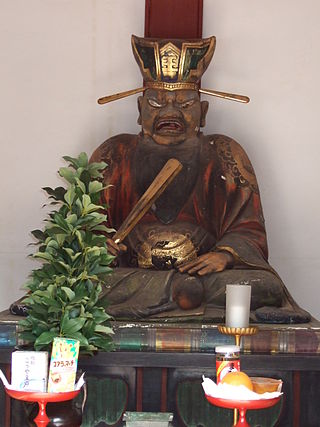Contents
| |||||
| Decades: | |||||
|---|---|---|---|---|---|
| See also: | Other events of 1721 History of Japan • Timeline • Years | ||||
Events in the year 1721 in Japan .
| |||||
| Decades: | |||||
|---|---|---|---|---|---|
| See also: | Other events of 1721 History of Japan • Timeline • Years | ||||
Events in the year 1721 in Japan .

Anime is hand-drawn and computer-generated animation technique originating from Japan. Outside Japan and in English, anime refers specifically to animation produced in Japan. However, in Japan and Japanese, anime describes all animated works, regardless of style or origin. Many works of animation with a similar style to Japanese animation are also produced outside Japan. Video games sometimes also feature themes and art styles that are sometimes labelled as anime.

Japan is an island country in East Asia, located in the Pacific Ocean off the northeast coast of the Asian mainland. It is bordered on the west by the Sea of Japan and extends from the Sea of Okhotsk in the north to the East China Sea in the south. The Japanese archipelago consists of four major islands—Hokkaido, Honshu, Shikoku, and Kyushu—and thousands of smaller islands, covering 377,975 square kilometres (145,937 sq mi). With a population of more than 125 million as of 2020, Japan is the 11th most populous country. Tokyo is its capital and largest city. Japan is divided into 47 administrative prefectures and eight traditional regions. About three-quarters of the country's terrain is mountainous and heavily forested, concentrating its agriculture and highly urbanized population along its eastern coastal plains. Greater Tokyo is the world's most populous metropolitan area, with more than 38 million inhabitants as of 2016. Part of the Pacific Ring of Fire, Japan's islands are prone to destructive earthquakes and tsunamis.

Japanese is the principal language of the Japonic language family spoken by the Japanese people. It has around 120 million speakers, primarily in Japan, the only country where it is the national language, and within the Japanese diaspora worldwide.

World War II or the Second World War was a global conflict between two coalitions: the Allies and the Axis powers. Nearly all of the world's countries—including all the great powers—participated, with many investing all available economic, industrial, and scientific capabilities in pursuit of total war, blurring the distinction between military and civilian resources. Tanks and aircraft played major roles, with the latter enabling the strategic bombing of population centres and delivery of the only two nuclear weapons ever used in war. World War II was the deadliest conflict in history, resulting in 70 to 85 million fatalities, more than half of which were civilians. Millions died in genocides, including the Holocaust of European Jews, and by massacres, starvation, and disease. Following the Allied powers' victory, Germany, Austria, Japan, and Korea were occupied, and war crimes tribunals were conducted against German and Japanese leaders.

Chikamatsu Monzaemon was a Japanese dramatist of jōruri, the form of puppet theater that later came to be known as bunraku, and the live-actor drama, kabuki. The Encyclopædia Britannica has written that he is "widely regarded as the greatest Japanese dramatist". His most famous plays deal with double-suicides of honor bound lovers. Of his puppet plays, around 70 are jidaimono (時代物) and 24 are sewamono (世話物). The domestic plays are today considered the core of his artistic achievement, particularly works such as The Courier for Hell (1711) and The Love Suicides at Amijima (1721). His histories are viewed less positively, though The Battles of Coxinga (1715) remains praised.

Masahiro Shinoda is a Japanese retired film director, originally associated with the Shochiku Studio, who came to prominence as part of the Japanese New Wave in the 1960s.

Shinigami are kami that invite humans toward death in certain aspects of Japanese religion and culture. Shinigami have been described as monsters, helpers, and creatures of darkness. Shinigami are used for tales and religions in Japanese culture.

The 2020 Summer Olympics, officially the Games of the XXXII Olympiad and officially branded as Tokyo 2020, were an international multi-sport event held from 23 July to 8 August 2021 in Tokyo, Japan, with some preliminary events that began on 21 July 2021. Tokyo was selected as the host city during the 125th IOC Session in Buenos Aires, Argentina on 7 September 2013.
The Love Suicides at Amijima is a domestic play (sewamono) by Japanese playwright Chikamatsu Monzaemon. Originally written for the bunraku puppet theatre, it was adapted into kabuki shortly after its premiere on 3 January 1721. It is widely regarded as one of his greatest domestic plays and was hailed by Donald Keene as “Chikamatsu’s masterpiece”.
Some Prefer Nettles is a 1929 novel by Jun'ichirō Tanizaki. It was first published in 1928–9 as a newspaper serial. The novel is often regarded as the most autobiographical of Tanizaki's works and one of his finest novels.

Double Suicide is a 1969 Japanese historical drama film directed by Masahiro Shinoda. It is based on the 1721 bunraku play The Love Suicides at Amijima by Monzaemon Chikamatsu.

Four Major Plays of Chikamatsu is a collection of four major dramas by the famous Japanese playwright Chikamatsu Monzaemon. The four plays were first translated by Donald Keene in 1961, and have appeared in various collections and books over the years; Four Major Plays contains a Preface, an Introduction, and two appendices in addition, and is published by Columbia University Press.

On 6 and 9 August 1945, the United States detonated two atomic bombs over the Japanese cities of Hiroshima and Nagasaki. The bombings killed between 150,000 and 246,000 people, most of whom were civilians, and remain the only use of nuclear weapons in an armed conflict. Japan surrendered to the Allies on 15 August, six days after the bombing of Nagasaki and the Soviet Union's declaration of war against Japan and invasion of Japanese-occupied Manchuria. The Japanese government signed the instrument of surrender on 2 September, effectively ending the war.

Sakata Tōjūrō IV was a Japanese kabuki actor in the Kamigata style and was officially designated a Living National Treasure. Unlike most kabuki actors, he performed both male and female roles, and was renowned as both a skilled wagotoshi and onnagata. He was the fourth in the line of Sakata Tōjūrō, having revived the name after a lapse of over 230 years.
The Courier for Hell or Courier of Hell is a love-suicide play by the Japanese writer Chikamatsu Monzaemon, written in 1711. It follows a similar storyline to some of his other love-suicide plays, including The Love Suicides at Sonezaki and The Love Suicides at Amijima. The Courier for Hell was based on real events that took place in Osaka in 1710. It is one of the most celebrated of his domestic plays.

Donald Howard Shively was an American academic, historian, Japanologist, author and professor emeritus of East Asian Languages and Cultures at the University of California, Berkeley. He was a leader of Japan studies in the United States.
Azuma is both a Japanese surname and a masculine Japanese given name. Notable people with the name include:
Taeko Tomioka was a Japanese writer.

A tamatebako (玉手箱) "jeweled hand box", "jewel box", "jeweled box", "treasure box", "casket", etc., is a mysterious box that in the Japanese folk tale "Urashima Tarō", is a parting gift that the fisherman Urashima Tarō receives from mistress of the sea (Otohime), after his stay at the Dragon Palace, to which he was invited after saving a turtle.
Kojima Gyokuhō was a Japanese artist. Little is known about him, except that he worked with the Kyoto City publisher Happōdō. He rejected the Western concept that art was an expression of the artist's individuality. Rather, he embraced the traditional method of producing woodblock prints through the cooperation of a designer (artist), a woodblock carver, a printer, and a publisher. He also favored traditional Japanese subjects, such as Japanese textiles, kabuki, and ukiyo-e masterpieces.